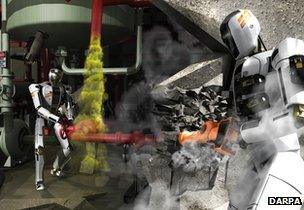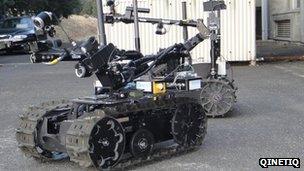Disaster zone robot competition announced by Pentagon
- Published

Darpa says it wants robots to be able to interact with more tools when deployed to a disaster zone
A competition to develop next-generation robots capable of saving lives in disaster zones has been unveiled by the Pentagon's advanced research laboratory.
Darpa says it wants " <link> <caption>adaptable robots with the ability to use human tools</caption> <url href="http://www.darpa.mil/NewsEvents/Releases/2012/04/10.aspx" platform="highweb"/> </link> - from hand tools to vehicles".
It plans to hold a series of emergency response physical challenges.
A $2m (£1.3m) prize is being offered to the team with the best technology. The competition begins in October.
The agency says it hopes software engineers, video game developers and other experts from fields outside robotics will take part "to increase the diversity of innovative solutions".
Radiation-resistant
Robots have already been deployed into danger zones.
After the Fukushima nuclear plant meltdown in 2011, Japanese authorities used <link> <caption>unmanned vehicles and "first responder" robots</caption> <url href="http://www.prweb.com/releases/Fukushima/robots/prweb8309488.htm" platform="highweb"/> </link> developed by the British firm Qintetiq to move heavy debris and measure radiation levels.
The US Army has also <link> <caption>used robots in Iraq and Afghanistan</caption> <url href="http://www.army.mil/article/47344/Army_building_smarter_robots/" platform="highweb"/> </link> to clear buildings and check for explosive devices.
However, Darpa says more work needs to be done to make the machines interact with humans more naturally.
"This challenge is going to test supervised autonomy in perception and decision-making, mounted and dismounted mobility, dexterity, strength and endurance in an environment designed for human use but degraded due to disaster," said Gill Pratt, Darpa's programme manager.
"Adaptability is also essential because we don't know where the next disaster will strike."
Autonomous automatons
Jeremy Wyatt, reader in robotics at the University of Birmingham, suggested that efforts should focus on making the machines less dependent on human operators.

Qinetiq's talon "first responder" robots were used to map radiation readings in Japan
"Robots operated by humans have been used since the World Trade Center disaster, but no completely autonomous robots have been deployed in a real disaster to date," he said.
"Robot autonomy is improving steadily, but often it is easier and more reliable to have a human operate the robot remotely. Also autonomy raises safety and reliability concerns.
"Having said that I would expect to see limited autonomy used in robots for mapping and surveillance at disasters at some point in the next decade."
War robots
Darpa's last grand challenge - a driverless car race across 150 miles (241km)of desert - spurred on major developments in the field, said Noel Sharkey, professor of artificial intelligence and robotics at The University of Sheffield.
However, he expressed concerns about the latest contest.
"I am sure that some good spin-offs will come from it," he told the BBC.
"But when we look at the tasks more closely and the fact that Darpa is funding the challenge, we need to be realistic about the true intentions.
"This is part of the US war machine with the aim of developing robots for the battlefield. While there may be very good civil applications, these machines are clearly moving us toward the automation and industrialisation of warfare."
- Published18 April 2011
- Published8 March 2012